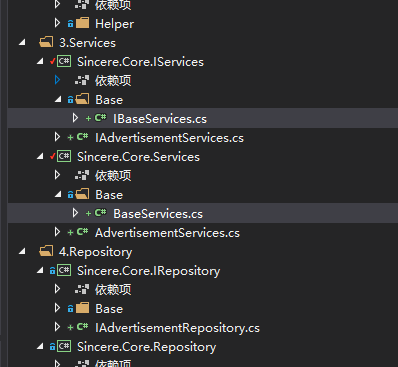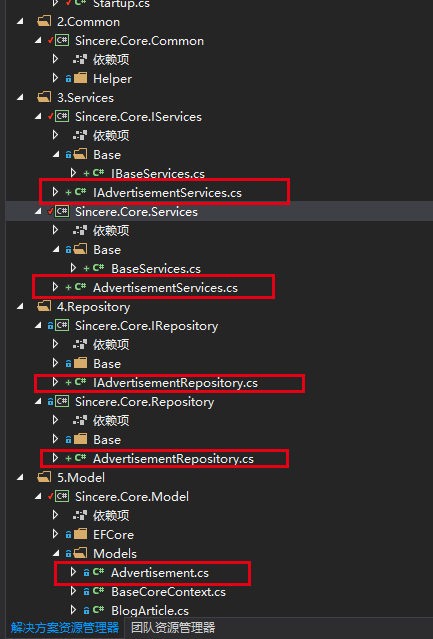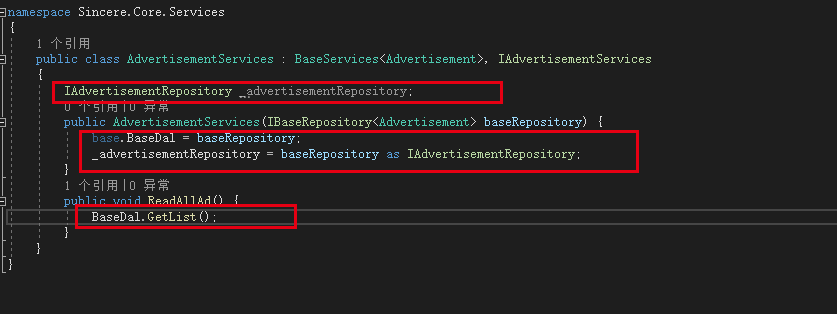.netCore+Vue 搭建的简捷开发框架 (3)-- Services层实现
继续交作业:
上一篇作业中我们实现了 Repository仓储层的应用。并为我们的框架引入了EFCore 详见:
.netCore+Vue 搭建的简捷开发框架 (2)--仓储层实现和EFCore 的使用
接下来我们继续来实现Services 层,同样,我们在Services 和IServices 中增加 Base 文件夹。并创建BaseServices.cs 和IBaseServices.cs
如图:

其中BaseServices.cs 和 IBaseServices.cs 代码如下:

1 using Sincere.Core.IRepository.Base; 2 using Sincere.Core.IServices.Base; 3 using Sincere.Core.Model; 4 using System; 5 using System.Collections.Generic; 6 using System.Data; 7 using System.Data.SqlClient; 8 using System.Linq.Expressions; 9 using System.Text; 10 using System.Threading.Tasks; 11 12 namespace Sincere.Core.Services.Base 13 { 14 public class BaseServices<TEntity> : IBaseServices<TEntity> where TEntity : class, new() 15 { 16 //public IBaseRepository<TEntity> baseDal = new BaseRepository<TEntity>(); 17 public IBaseRepository<TEntity> BaseDal;//通过在子类的构造函数中注入,这里是基类,不用构造函数 18 19 public async Task<int> Del(TEntity model) 20 { 21 return await BaseDal.Del(model); 22 } 23 24 public async Task<int> DelBy(Expression<Func<TEntity, bool>> delWhere) 25 { 26 return await BaseDal.DelBy(delWhere); 27 } 28 29 public async Task<int> Execute(string sql, List<SqlParameter> parms, CommandType cmdType = CommandType.Text) 30 { 31 return await BaseDal.Execute(sql,parms,cmdType); 32 } 33 34 public async Task<List<TEntity>> GetList() 35 { 36 return await BaseDal.GetList(); 37 } 38 39 public async Task<List<TEntity>> GetListBy(Expression<Func<TEntity, bool>> whereLambda) 40 { 41 return await BaseDal.GetListBy(whereLambda); 42 } 43 44 public async Task<List<TEntity>> GetListBy<TKey>(Expression<Func<TEntity, bool>> whereLambda, Expression<Func<TEntity, TKey>> orderLambda, bool isAsc = true) 45 { 46 return await BaseDal.GetListBy(whereLambda,orderLambda,isAsc); 47 } 48 49 public async Task<List<TEntity>> GetListBy<TKey>(int top, Expression<Func<TEntity, bool>> whereLambda, Expression<Func<TEntity, TKey>> orderLambda, bool isAsc = true) 50 { 51 return await BaseDal.GetListBy(top, whereLambda, orderLambda, isAsc); 52 } 53 54 public async Task<List<TEntity>> GetListBy<TKey1, TKey2>(Expression<Func<TEntity, bool>> whereLambda, Expression<Func<TEntity, TKey1>> orderLambda1, Expression<Func<TEntity, TKey2>> orderLambda2, bool isAsc1 = true, bool isAsc2 = true) 55 { 56 return await BaseDal.GetListBy( whereLambda, orderLambda1,orderLambda2, isAsc1,isAsc2); 57 } 58 59 public async Task<List<TEntity>> GetListBy<TKey1, TKey2>(int top, Expression<Func<TEntity, bool>> whereLambda, Expression<Func<TEntity, TKey1>> orderLambda1, Expression<Func<TEntity, TKey2>> orderLambda2, bool isAsc1 = true, bool isAsc2 = true) 60 { 61 return await BaseDal.GetListBy(top, whereLambda, orderLambda1, orderLambda2, isAsc1, isAsc2); 62 } 63 64 public async Task<TEntity> GetModelById(Expression<Func<TEntity, bool>> whereLambda) 65 { 66 return await BaseDal.GetModelById( whereLambda); 67 } 68 69 public async Task<List<TEntity>> GetPagedList<TKey>(int pageIndex, int pageSize, Expression<Func<TEntity, bool>> whereLambda, Expression<Func<TEntity, TKey>> orderByLambda, bool isAsc = true) 70 { 71 return await BaseDal.GetPagedList(pageIndex,pageSize, whereLambda,orderByLambda,isAsc); 72 } 73 74 public async Task<PageModel<TEntity>> GetPagedList<TKey>(Expression<Func<TEntity, bool>> whereLambda, Expression<Func<TEntity, TKey>> orderByLambda, bool isAsc = true, int pageIndex = 1, int pageSize = 20) 75 { 76 return await BaseDal.GetPagedList( whereLambda, orderByLambda, isAsc, pageIndex, pageSize); 77 } 78 79 public async Task<bool> Insert(TEntity model) 80 { 81 return await BaseDal.Insert(model); 82 } 83 84 public async Task<bool> InsertRange(List<TEntity> datas) 85 { 86 return await BaseDal.InsertRange(datas); 87 } 88 89 public async Task<int> Modify(TEntity model) 90 { 91 return await BaseDal.Modify(model); 92 } 93 94 public async Task<int> Modify(TEntity model, params string[] propertyNames) 95 { 96 return await BaseDal.Modify(model,propertyNames); 97 } 98 99 public async Task<int> ModifyBy(TEntity model, Expression<Func<TEntity, bool>> whereLambda, params string[] modifiedPropertyNames) 100 { 101 return await BaseDal.ModifyBy(model, whereLambda,modifiedPropertyNames); 102 } 103 104 public async Task<List<TEntity>> Query(string sql, List<SqlParameter> parms, CommandType cmdType = CommandType.Text) 105 { 106 return await BaseDal.Query(sql, parms, cmdType); 107 } 108 109 public void RollBackChanges() 110 { 111 BaseDal.RollBackChanges(); 112 } 113 } 114 115 }

1 using Sincere.Core.Model; 2 using System; 3 using System.Collections.Generic; 4 using System.Data; 5 using System.Data.SqlClient; 6 using System.Linq.Expressions; 7 using System.Text; 8 using System.Threading.Tasks; 9 10 namespace Sincere.Core.IServices.Base 11 { 12 public interface IBaseServices<TEntity> where TEntity : class 13 { 14 Task<int> Execute(string sql, List<SqlParameter> parms, CommandType cmdType = CommandType.Text); 15 Task<List<TEntity>> Query(string sql, List<SqlParameter> parms, CommandType cmdType = CommandType.Text); 16 Task<bool> Insert(TEntity model); 17 Task<bool> InsertRange(List<TEntity> datas); 18 19 Task<int> Del(TEntity model); 20 21 Task<int> DelBy(Expression<Func<TEntity, bool>> delWhere); 22 23 Task<int> Modify(TEntity model); 24 25 Task<int> Modify(TEntity model, params string[] propertyNames); 26 27 Task<int> ModifyBy(TEntity model, Expression<Func<TEntity, bool>> whereLambda, params string[] modifiedPropertyNames); 28 29 Task<List<TEntity>> GetList(); 30 31 Task<List<TEntity>> GetListBy(Expression<Func<TEntity, bool>> whereLambda); 32 33 Task<TEntity> GetModelById(Expression<Func<TEntity, bool>> whereLambda); 34 35 Task<List<TEntity>> GetListBy<TKey>(Expression<Func<TEntity, bool>> whereLambda, Expression<Func<TEntity, TKey>> orderLambda, bool isAsc = true); 36 37 Task<List<TEntity>> GetListBy<TKey>(int top, Expression<Func<TEntity, bool>> whereLambda, Expression<Func<TEntity, TKey>> orderLambda, bool isAsc = true); 38 39 Task<List<TEntity>> GetListBy<TKey1, TKey2>(Expression<Func<TEntity, bool>> whereLambda, Expression<Func<TEntity, TKey1>> orderLambda1, Expression<Func<TEntity, TKey2>> orderLambda2, bool isAsc1 = true, bool isAsc2 = true); 40 41 Task<List<TEntity>> GetListBy<TKey1, TKey2>(int top, Expression<Func<TEntity, bool>> whereLambda, Expression<Func<TEntity, TKey1>> orderLambda1, Expression<Func<TEntity, TKey2>> orderLambda2, bool isAsc1 = true, bool isAsc2 = true); 42 43 Task<List<TEntity>> GetPagedList<TKey>(int pageIndex, int pageSize, Expression<Func<TEntity, bool>> whereLambda, Expression<Func<TEntity, TKey>> orderByLambda, bool isAsc = true); 44 45 Task<PageModel<TEntity>> GetPagedList<TKey>(Expression<Func<TEntity, bool>> whereLambda, Expression<Func<TEntity, TKey>> orderByLambda, bool isAsc = true, int pageIndex = 1, int pageSize = 20); 46 47 void RollBackChanges(); 48 } 49 50 }
需要说明的是,在BaseServices.cs 中我们通过依赖注入的方式引入了IBaseRepository 。

具体的引用需要在子类的构造函数中注入。
结合上一篇中的内容,我们现在的框架就已经搭建好了最基础的框架模型中的Services 和 Repository 层。
为了验证各层之间的调用。接下来我们依旧参照 张老师的课程中使用的Advertisement 类,来进行测试。
我们需要依次建立 Advertisement.cs (Model,已经在上一节中建好) 、IAdvertisementRepository(IRepository 中),AdvertisementRepository(Repository 中)、IAdvertisementServices(IServices中)、AdvertisementServices(Services中)
建好后的代码结构如下:

以后我们在此框架上开发其他服务的时候,也参照这样的目录结构建立相应文件。
接下来依次介绍各个文件,以及其实现过程。
首先是IAdvertisementRepository.cs
这个没什么好说的,继承自 IBaseRepository<Advertisement>。这里面我没有写其他的业务逻辑,是一个空的接口。代码如下:

1 using Sincere.Core.IRepository.Base; 2 using Sincere.Core.Model.Models; 3 using System; 4 using System.Collections.Generic; 5 using System.Text; 6 7 namespace Sincere.Core.IRepository 8 { 9 public interface IAdvertisementRepository : IBaseRepository<Advertisement> 10 { 11 12 } 13 }
接下来是AdvertisementRepository.cs ,这里继承自BaseRepository<Advertisement>, 并实现 IAdvertisementRepository接口。代码如下:

1 using Sincere.Core.IRepository; 2 using Sincere.Core.Model.EFCore; 3 using Sincere.Core.Model.Models; 4 using Sincere.Core.Repository.Base; 5 using System; 6 using System.Collections.Generic; 7 using System.Text; 8 9 namespace Sincere.Core.Repository 10 { 11 public class AdvertisementRepository : BaseRepository<Advertisement>, IAdvertisementRepository 12 { 13 public AdvertisementRepository(IBaseContext mydbcontext) : base(mydbcontext) 14 { 15 16 } 17 } 18 }
这里需要说明的是,因为我在BaseRepository 的构造函数中,使用了有参数的构造函数
public BaseRepository(IBaseContext mydbcontext)
{
this._db = mydbcontext as BaseCoreContext;
this._dbSet = _db.Set<TEntity>();
}
所以在AdvertisementRepository 中,将注入的mydbContext 同步注入到BaseRepository 中。

仓储层的逻辑基本就这样了,接下来写Services中的实现。
同样,首先是接口IAdvertisementServices,继承IBaseServices<Advertisement>。没什么好说的,这里为了假装有一个方法,叫做ReadAllAd(),代码如下:

1 using Sincere.Core.IServices.Base; 2 using Sincere.Core.Model.Models; 3 using System; 4 using System.Collections.Generic; 5 using System.Text; 6 7 namespace Sincere.Core.IServices 8 { 9 public interface IAdvertisementServices : IBaseServices<Advertisement> 10 { 11 void ReadAllAd(); 12 } 13 }
最后就是AdvertisementServices了,未来的开发中,我们大部分的业务逻辑都将在这里实现,于仓储层的实现类似,也是继承: BaseServices<Advertisement>, 实现 IAdvertisementServices接口。
代码如下:

1 using Sincere.Core.IRepository; 2 using Sincere.Core.IRepository.Base; 3 using Sincere.Core.IServices; 4 using Sincere.Core.Model.Models; 5 using Sincere.Core.Services.Base; 6 using System; 7 using System.Collections.Generic; 8 using System.Text; 9 10 namespace Sincere.Core.Services 11 { 12 public class AdvertisementServices : BaseServices<Advertisement>, IAdvertisementServices 13 { 14 IAdvertisementRepository _advertisementRepository; 15 public AdvertisementServices(IBaseRepository<Advertisement> baseRepository) { 16 base.BaseDal = baseRepository; 17 _advertisementRepository = baseRepository as IAdvertisementRepository; 18 } 19 public void ReadAllAd() { 20 21 } 22 } 23 }
这里有些地方需要进行一下说明。首先就是通过依赖注入的方式,将IBaseRepository 注入进来。

在ReadAllAd 方法中的引用如上图所示。
到此为止,各个层中的实现就都完成了。但是我们在Controller 中该怎么引用呢?
这个地方涉及的东西比较多,比如NetCore 的依赖注入、利用反射机制进行注入、NetCore 的Startup.cs 类等内容。准备用下一节的内容来进行整体说明。谢谢。
谢谢。




 浙公网安备 33010602011771号
浙公网安备 33010602011771号